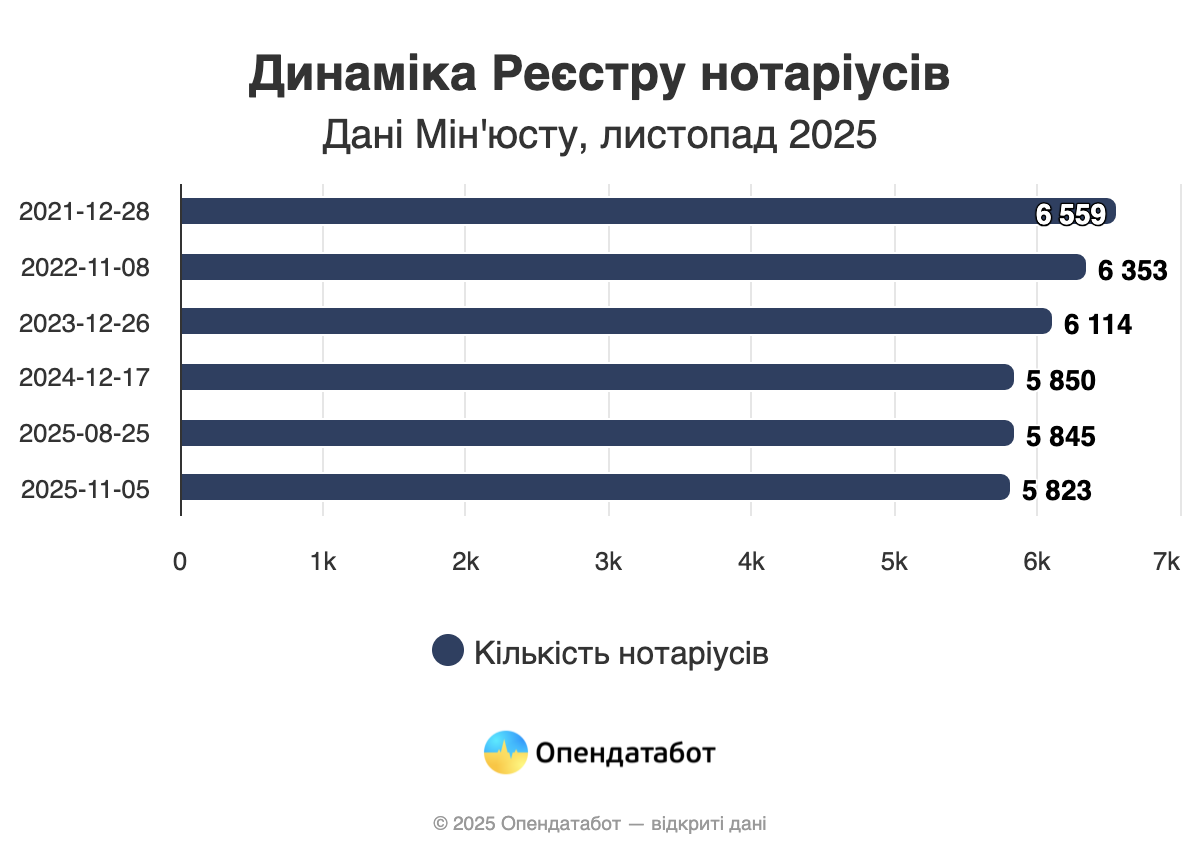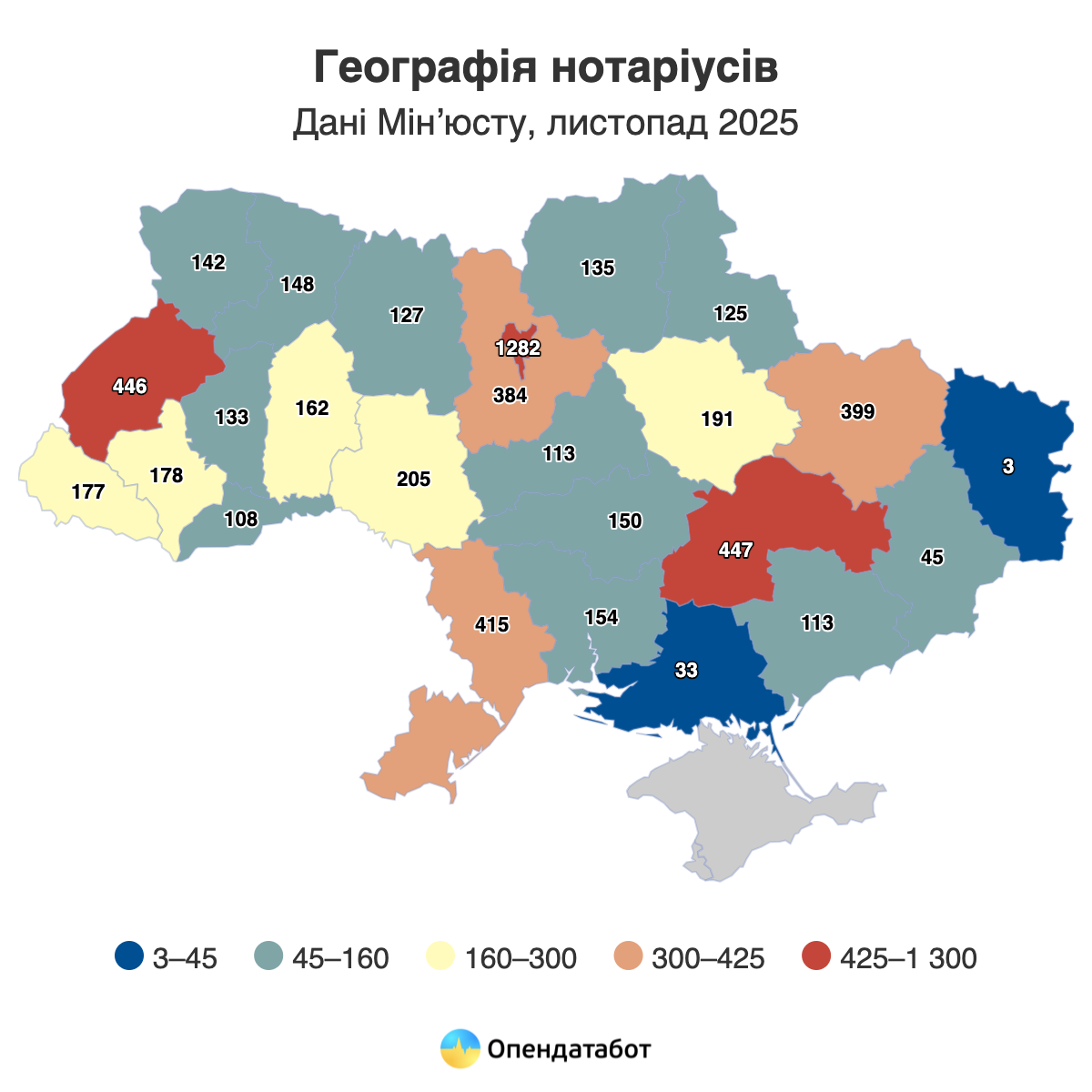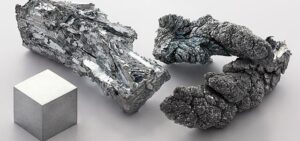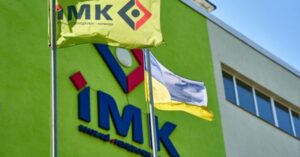
Women predominate in the profession, but men have more work
According to the Ministry of Justice of Ukraine, more than 5,800 active notaries are currently listed in the Register. The number of notaries has decreased by 11% since the start of the full-scale war. 82% of notaries in the Register are women, but men have a heavier workload. A notary from Lviv region used a record 24,600 forms this year. 63 practicing notaries have been working for over 29 years. One in five Ukrainian notaries works in Kyiv.
There are currently 5,823 practicing notaries listed in the Register of Notaries. Since the start of the full-scale war, the number of notaries has decreased by 11%. At the same time, 63 practicing notaries have been working for over 29 years — since 1996.
It should be noted that the Register is constantly updated: some specialists are added, some are removed. You can find, check, and select a notary on the Notary Register page in OpenDataBot. In addition, for each specialist, you can check the number and validity of their license, as well as see their workload — based on the number of notarial forms used year after year.
The highest concentration of notaries is traditionally in the capital — 1,282, meaning that one in five Ukrainian notaries works in Kyiv. This is followed by Dnipropetrovsk and Lviv regions — 447 and 446 respectively, as well as Odesa (415) and Kharkiv (399) regions.
Women significantly dominate the profession, accounting for 82% of practitioners. At the same time, men have more work: 702 notarial forms per year for women versus 992 for men. On average, one notary uses more than 60 forms per month.
The busiest specialists are in the Cherkasy region, where one notary uses 1,287 forms per year. High figures are also seen in the Zhytomyr and Khmelnytsky regions — 1,054 each, in Vinnytsia — 1,043, and in Ivano-Frankivsk — 959.
This year’s absolute record belongs to a notary from Lviv region, who used 24,606 forms this year — that is, about 78 forms per day, working without days off. This is a record for the entire country.
https://opendatabot.ua/analytics/notary-2025-11



Imports of zinc and zinc products to Ukraine in January-October 2025 decreased by 8% to $45.52 million, while exports tripled to $1.14 million.
In October, imports amounted to $4.3 million, exports — $0.19 million.
In 2024, zinc imports increased by 27.5% to $58.61 million, and exports increased 3.4 times to $0.56 million.
Pure metallic zinc is used to recover precious metals, protect steel from corrosion, and for other purposes.

Agroholding IMC (IMC S.A.) will pay the company’s shareholders interim dividends for 2025 totaling EUR12.43 million, according to the company’s website.
According to the decision of the IMC Board of Directors, interim dividends of EUR0.35 per share will be paid on November 27, 2025, to shareholders who were registered as of November 20 of this year.
“Luxembourg personal income tax at a rate of 15% will be withheld from the dividends. Dividends will be paid in euros,” the agricultural holding added.
The chairman of the board of directors, reporting to the supervisory board, specified that for the period from January 1, 2025, to September 30, 2025, IMC received a profit of EUR 31.89 million. At the same time, the profit carried forward to subsequent periods amounted to EUR 7.34 million, issue income – EUR 17.84 million, interim dividends – EUR 22.37 million. The amount to be distributed may not exceed EUR 34.7 million.
“The Board of Directors intends to declare interim dividends totaling EUR 12.43 million (i.e., EUR 0.35 per share), which will be distributed equally among the company’s shareholders in proportion to their number of shares on the distribution date,” the statement said.
Agroholding “IMK” is an integrated group of companies operating in the Sumy, Poltava, and Chernihiv regions (northern and central Ukraine) in the segments of crop production, elevators, and warehouses. The land bank is 116,000 hectares, storage capacity is 554,000 tons, and the 2024 harvest is 864,000 tons.
IMK ended 2024 with a net profit of $54.54 million, compared to a net loss of $21.03 million in 2023. Revenue increased by 52% to $211.29 million, gross profit quadrupled to $109.10 million, and normalized EBITDA increased 25-fold to $86.11 million.

Ukraine sharply increased imports of lead and lead products—by 8.9 times, to $6.89 million in the first ten months of 2025.
At the same time, exports fell by 16.4% to $8.17 million.
For comparison, in 2024, lead imports increased 2.4 times to $2.39 million, while exports fell by almost a quarter to $11.4 million.
Lead is currently mainly used in the production of lead-acid batteries for the automotive industry. In addition, lead is used in the manufacture of bullets and certain alloys.

Estonia has decided to allocate €3.5 million to Ukraine for the purchase of Starlink satellite communication systems as part of an IT coalition jointly led by Estonia and Luxembourg. This was reported on the official website of the Estonian Ministry of Defense.
As noted by Estonian Defense Minister Hanno Pevkur, the funds are intended to strengthen Ukraine’s IT capabilities and increase the effectiveness of the Armed Forces on the battlefield.
“Ukraine has confirmed to us that it needs support to secure Starlink connectivity, and it is clear that this is extremely important assistance for them, which has a noticeable effect on the battlefield. Starlink’s capabilities are particularly critical given Ukraine’s desire to significantly increase the number of drone units that require high-performance internet connectivity,” Pevkur said.
He stressed that Ukraine is fighting every day for the freedom of all of Europe, including Estonia.
“Therefore, in addition to weapons, information and technological support is also critically important. I am glad that we can help Ukraine strengthen its IT capabilities, thereby increasing its chances of winning a war that claims hundreds of lives every day,” the minister added.
The €3.5 million in funding comes from Estonia’s aid package to Ukraine planned for 2025. The funds will be transferred to Ukraine through an IT coalition established by Estonia and Luxembourg and will be used for the joint purchase of Starlink systems.

In January-October of this year, Ukraine reduced imports of coke and semi-coke in physical terms by 4.1% compared to the same period last year, to 557,451 tons.
According to statistics released by the State Customs Service (SCS) on Wednesday, coke imports in monetary terms for this period decreased by 9.6% to $188.829 million. It was mainly imported from Poland (92.36% of supplies in monetary terms), Indonesia (5.07%), and the Czech Republic (2.54%).
During this period, Ukraine exported 3 tons of coke worth $2,000 to Albania.
As reported, Metinvest suspended the operation of the Pokrovsk Coal Group in January this year due to changes in the situation on the front line, electricity shortages, and the deterioration of the security situation.
Last year, Ukraine increased its imports of coke and semi-coke in physical terms by 2.01 times compared to 2023, to 661,487 thousand tons, importing it mainly from Poland (84.76% of supplies in monetary terms), Colombia (7.74%), and Hungary (2.69%). In monetary terms, imports increased by 81.9% to $235.475 million.
In 2024, the country exported 1,601 thousand tons of 84.76% coke worth $368 thousand to Moldova (99.18%) and Latvia (0.82%), while in January, March, October, and November 2024, there were no exports, whereas in 2023, they amounted to 3,383 thousand tons worth $787 thousand.